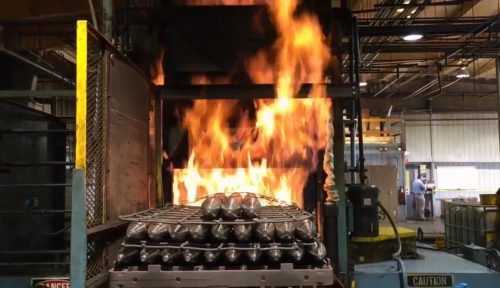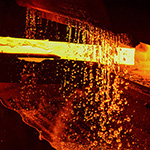How Does Heat Treating Work?
Many metal products require heat treating during the manufacturing process to enhance durability, performance, and certain properties. Here, we’ll go over the various steps of the heat treating process as well as Modern Industries’ heat treating capabilities.
What Is Heat Treating?

Nearly every product uses heat treating during its manufacture. This process entails heating and cooling metal under tight controls, which improves the metal’s strength, function, and characteristics. Heat treating can either soften the metal, which improves its formability, or harden the metal, which improves its strength. It’s also possible to add a hard surface to softer parts, improving their abrasion resistance.
Some applications may use heat treating to form a corrosion-resistant skin for parts that are typically vulnerable to corrosion. Others may use the process to strengthen brittle materials. While iron and steel comprise the bulk of heat-treated materials, the process can also be used with alloys of magnesium, copper, aluminum, titanium, and nickel.
Heat Treating Processes
The heat treating process involves three main steps, including:
Heating to a Specific Temperature
During this stage of the heat treating process, the primary goal is to ensure the uniform heating of metal materials. The process can achieve uniformity by slowly heating the metal. Otherwise, uneven heating of the metal materials could cause one section to expand more rapidly, which may lead to cracks or distortion on the surface of the metal.
The appropriate heating rate for this process depends on a couple of key factors:
- The metal’s heat conductivity. Metals that have high heat conductivity heat up quicker than metals with low heat conductivity.
- The metal’s condition. Parts and tools that have previously undergone hardening or stressing will require slower heat treating than those that haven’t.
Soaking Stage/Holding at the Set Temperature for the Right Amount of Time
This stage helps keep the metal at the right temperature until it reaches the desired internal structure. The length of time needed to maintain the appropriate temperature is known as the “soaking period.” To calculate the right soaking period, you must perform a chemical analysis and calculate the metal’s mass. When working with uneven cross-sections, you can use the largest section to determine the right soaking period.
Cooling Based on Prescribed Methods
During this final stage of the heat treating process, you’ll need to cool the metal until it reaches room temperature. This involves different methods depending on the specific metal used. For instance, the metal may require a cooling medium in the form of a liquid, solid, gas, or a combination of states. The cooling rate will depend on the type of metal and the cooling medium. The choices you make during the cooling period will dictate the properties of the final metal part.
The process often reaches temperatures as high as 2400°F, and the soaking period may last anywhere from a few seconds to 60 hours or longer. Applications may also use cryogenic processes with treatment at temperatures of -120°F or lower.
Some metal materials go through a slow cooling process within the furnace, while others require faster cooling or quenching with media such as brine, water, polymer solutions, molten metals, oils, and gases. Each type of quenching medium has certain properties that make it suitable for specific applications; however, most parts rely on oil, gases, water, or polymers.
Heat Treat Services from Modern Industries

Modern Industries has grown into the largest heat treating source in Northwestern Pennsylvania, and we’re among the largest in the tri-state area. We regularly provide full heat treating services for customers in the medical, automotive, military, aerospace, and tool & die industries.
Depending on what our customers require, our capabilities include:
- Annealing
- Through Hardening
- Carbonitriding and Carburizing
- Ferritic Nitrocarburizing
- Nitriding
- Solution Treat and Age
- Vacuum Heat Treating
- Cryogenics to -300°F
- Aluminum Heat Treating
- Stress Relieving
In addition, we offer a range of special processes to help complement or fit your heat treating requirements. These special processes include, but are not limited to:
- Double Disc Grinding
- Deburring
- Tumbling
- Shot Blasting or Sand Blasting
- CNC Straightening
- Metallurgic Consulting
- Vacuum Oil Quenching
- State-of-the-art Digital Metallography
- Trucking and Door-to-Door Service
- Full On-Site Nadcap Accredited Materials Testing Laboratory Services
Get the Heat Treating Services You Need at Modern Industries
If you require heat treating services for your application, Modern Industries offers some of the most reliable processes based on your needs. To meet your specifications, we offer aluminum heat treatment, vacuum brazing, hardening, tempering, carburizing, and many other treatments.
For more information about our services, contact us today. To get started on a heat treatment solution, request a quote at any time.
